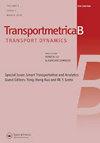Automatic bike sharing system planning from urban environment features
IF 3.4
2区 工程技术
Q2 TRANSPORTATION
引用次数: 0
Abstract
ABSTRACT The planning process for bike sharing systems is often complex, involving multiple stakeholders and several considerations: finding hotspots in the potential demand, and dimensioning the system, requires an intimate knowledge of urban mobility patterns and specific local features of the city. The significant costs associated with dynamic rebalancing of bike sharing systems, i.e. with moving bikes across the city to correct the demand imbalance and ensure that they are available where and when they are needed, make correct planning even more critical for the economic viability of the system. In this work, we consider urban environment data from multiple sources and different cities in Europe and the United States to design an automated planning pipeline to place stations in an area with no direct knowledge of the demand. The first step in the planning is to build models of activity patterns and correlate them with features of the urban environment such as land use and mass transit availability; these statistical models can then be used to expand an existing network or even create an entirely new one in a different city. A use case in New York City shows that our system can effectively plan a bike sharing system expansion, providing a valuable first step for the planning process and allowing system designers to identify gaps in existing systems and the locations of potential demand hotspots.从城市环境特征看自动共享单车系统规划
本文章由计算机程序翻译,如有差异,请以英文原文为准。
求助全文
约1分钟内获得全文
求助全文
来源期刊

Transportmetrica B-Transport Dynamics
TRANSPORTATION SCIENCE & TECHNOLOGY-
CiteScore
5.00
自引率
21.40%
发文量
53
期刊介绍:
Transportmetrica B is an international journal that aims to bring together contributions of advanced research in understanding and practical experience in handling the dynamic aspects of transport systems and behavior, and hence the sub-title is set as “Transport Dynamics”.
Transport dynamics can be considered from various scales and scopes ranging from dynamics in traffic flow, travel behavior (e.g. learning process), logistics, transport policy, to traffic control. Thus, the journal welcomes research papers that address transport dynamics from a broad perspective, ranging from theoretical studies to empirical analysis of transport systems or behavior based on actual data.
The scope of Transportmetrica B includes, but is not limited to, the following: dynamic traffic assignment, dynamic transit assignment, dynamic activity-based modeling, applications of system dynamics in transport planning, logistics planning and optimization, traffic flow analysis, dynamic programming in transport modeling and optimization, traffic control, land-use and transport dynamics, day-to-day learning process (model and behavioral studies), time-series analysis of transport data and demand, traffic emission modeling, time-dependent transport policy analysis, transportation network reliability and vulnerability, simulation of traffic system and travel behavior, longitudinal analysis of traveler behavior, etc.
 求助内容:
求助内容: 应助结果提醒方式:
应助结果提醒方式:


